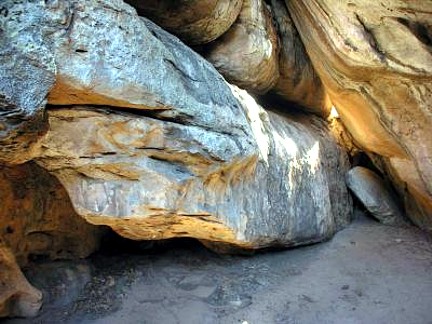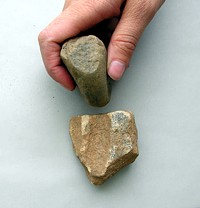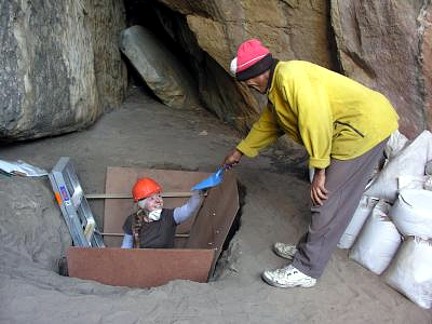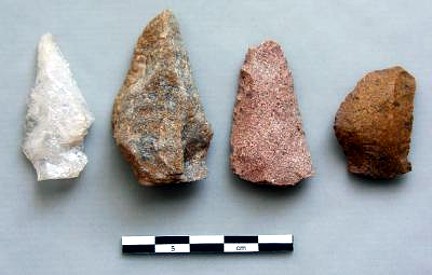Arqueólogos hallan el objeto religioso más antiguo del mundo
Photo: The newfound python carved from stone in a cave in the Tsodilo Hills of Botswana contained more than 400 indentations that could have been made only by humans. Sheila Coulson / University of Oslo
El sorprendente descubrimiento de una serie de artefactos con 70.000 años de antigüedad junto a una cabeza de pitón labrada en piedra supone el hallazgo de los restos de rituales religiosos más antiguos del mundo. Algo que cambia la concepción de los científicos sobre la inteligencia humana, que hasta el momento se creía no desarrolló la capacidad para realizar este tipo de rituales hasta hace unos 40.000 años.
El hallazgo tuvo lugar en las colinas del desierto de Kalahari en Botswana, donde los arqueólogos encontraron la serpiente de piedra, de más de metro y medio de altura y más de seis de longitud.
"Se pueden ver la boca y los ojos de la serpiente. Parece una pitón auténtica", señaló Sheila Coulson, arqueóloga de la Universidad de Oslo integrante de la excavación. "Los rayos de luz solar sobre los grabados le daban apariencia de piel de serpiente durante el día y por la noche, con la luz del fuego, daba la sensación de que la serpiente se movía", añadió Coulson.
Más significativo resulta que, cuando Coulson y sus colegas excavaron un hoyo de prueba cercano a la figura, encontraron puntas de lanza hechas de piedra que suponen fueron llevadas al lugar ex profeso y quemadas en lo que los científicos creen fue algún tipo de ritual.
"Solo las puntas de lanza rojas fueron quemadas. Fue una destrucción ritual de objetos (ya que) no había señales de que fuera una morada normal. No se encontró ninguna herramienta ordinaria en el lugar", señalaron los investigadores.
La zona del hallazgo, las Colinas de Tsodilo, es el lugar más elevado en kilómetros a la redonda. Los lugareños la conocen como las "Montañas de los dioses" o "la roca que susurra".
La leyenda del lugar cuenta que la humanidad desciende de la pitón, y que los áridos y milenarios lechos del río que circundan las colinas fueron creados por las pitones en su reptar a su alrededor en su incesante búsqueda de agua. Una leyenda que acrecienta el interés del hallazgo.
"Lo que hemos encontrado implica que los humanos eran más organizados y desarrollaron el pensamiento abstracto mucho antes en la historia de los que previamente se creía", señaló Coulson. "Todos los factores sugieren que Tsodilo ha sido conocido por la humanidad durante casi 100.000 años como un lugar muy especial en el paisaje prehistórico", añadió la arqueóloga.
El descubrimiento de la pitón no es lo único que ha llevado a los científicos a tan sorprendentes revelaciones: los arqueólogos hallaron además una cámara secreta tras el reptil labrado en piedra, con señales de haber sido usado durante años.
"El chamán, que continúa siendo una personalidad importante en la cultura San, podría haberse mantenido oculto en esa cámara secreta", explicó Coulson. "(Desde allí) tendría una buena vista del interior de la cueva manteniéndose oculto al mismo tiempo. Y cuando hablara escondido desde la cámara, daría la sensación de que la voz procedía de la propia serpiente. El chamán sería capaz así de controlarlo todo. Era perfecto", relató la arqueóloga a propósito del uso que los investigadores atribuyen a tan asombroso descubrimiento.
Fuente: TeleCinco.com, 1 de diciembre de 2006
Enlace: http://www.informativos.telecinco.es/objeto_
religioso_mas_antiguo/arqueologos/piton/dn_36999.htm
(2) World's oldest ritual discovered. Worshipped the python 70,000 years ago
Photo: In the excavation they found more than 13,000 artifacts. Sheila Coulson / University of Oslo
A startling archaeological discovery this summer changes our understanding of human history. While, up until now, scholars have largely held that mans first rituals were carried out over 40, 000 years ago in Europe, it now appears that they were wrong about both the time and place.
Associate Professor Sheila Coulson, from the University of Oslo, can now show that modern humans, Homo sapiens, have performed advanced rituals in Africa for 70,000 years. She has, in other words, discovered mankinds oldest known ritual.
The archaeologist made the surprising discovery while she was studying the origin of the Sanpeople. A group of the San live in the sparsely inhabited area of north-western Botswana known as Ngamiland.
Coulson made the discovery while searching for artifacts from the Middle Stone Age in the only hills present for hundreds of kilometers in any direction. This group of small peaks within the Kalahari Desert is known as the Tsodilo Hills and is famous for having the largest concentration of rock paintings in the world.
The Tsodilo Hills are still a sacred place for the San, who call them the Mountains of the Gods and the Rock that Whispers.
The python is one of the Sans most important animals. According to their creation myth, mankind descended from the python and the ancient, arid streambeds around the hills are said to have been created by the python as it circled the hills in its ceaseless search for water.
Sheila Coulsons find shows that people from the area had a specific ritual location associated with the python. The ritual was held in a little cave on the northern side of the Tsodilo Hills. The cave itself is so secluded and access to it is so difficult that it was not even discovered by archaeologists until the 1990s.
When Coulson entered the cave this summer with her three masters students, it struck them that the mysterious rock resembled the head of a huge python. On the six meter long by two meter tall rock, they found three-to-four hundred indentations that could only have been man-made.
"You could see the mouth and eyes of the snake. It looked like a real python. The play of sunlight over the indentations gave them the appearance of snake skin. At night, the firelight gave one the feeling that the snake was actually moving".
They found no evidence that work had recently been done on the rock. In fact, much of the rocks surface was extensively eroded.
When they saw the many indentations in the rock, the archaeologists wondered about more than when the work had been done. They also began thinking about what the cave had been used for and how long people had been going there. With these questions in mind, they decided to dig a test pit directly in front of the python stone.
At the bottom of the pit, they found many stones that had been used to make the indentations. Together with these tools, some of which were more than 70,000 years old, they found a piece of the wall that had fallen off during the work.
In the course of their excavation, they found more than 13,000 artifacts. All of the objects were spearheads and articles that could be connected with ritual use, as well as tools used in carving the stone. They found nothing else.
As if that were not enough, the stones that the spearheads were made from are not from the Tsodilo region but must have been brought from hundreds of kilometers away.
The spearheads are better crafted and more colourful than other spearheads from the same time and area. Surprisingly enough, it was only the red spearheads that had been burned.
"Stone age people took these colourful spearheads, brought them to the cave, and finished carving them there. Only the red spearheads were burned. It was a ritual destruction of artifacts. There was no sign of normal habitation. No ordinary tools were found at the site. Our find means that humans were more organised and had the capacity for abstract thinking at a much earlier point in history than we have previously assumed. All of the indications suggest that Tsodilo has been known to mankind for almost 100,000 years as a very special place in the pre-historic landscape. says Sheila Coulson.
Photo: The spearheads were particularly beautiful and were brought from hundreds of kilometers away. Sheila Coulson / University of Oslo
Sheila Coulson also noticed a secret chamber behind the python stone. Some areas of the entrance to this small chamber were worn smooth, indicating that many people had passed through it over the years.
"The shaman, who is still a very important person in San culture, could have kept himself hidden in that secret chamber. He would have had a good view of the inside of the cave while remaining hidden himself. When he spoke from his hiding place, it could have seemed as if the voice came from the snake itself. The shaman would have been able to control everything. It was perfect. The shaman could also have disappeared from the chamber by crawling out onto the hillside through a small shaft.
While large cave and wall paintings are numerous throughout the Tsodilo Hills, there are only two small paintings in this cave: an elephant and a giraffe. These images were rendered, surprisingly, exactly where water runs down the wall.
Sheila Coulson thinks that an explanation for this might come from San mythology.
In one San story, the python falls into a body of water and cannot get out by itself. The python is pulled from the water by a giraffe. The elephant, with its long trunk, is often used as a metaphor for the python.
"In the cave, we find only the San peoples three most important animals: the python, the elephant, and the giraffe. That is unusual. This would appear to be a very special place. They did not burn the spearheads by chance. They brought them from hundreds of kilometers away and intentionally burned them. So many pieces of the puzzle fit together here. It has to represent a ritual." concludes Sheila Coulson.
It was a major archaeological find five years ago that made it possible for Sheila Coulson to date the finds in this little cave in Botswana. Up until the turn of the century, archaeologists believed that human civilisation developed in Europe after our ancestors migrated from Africa. This theory was crushed by Archaeologist Christopher Henshilwood when he published his find of traces from a Middle Stone Age dwelling in the Blombos Cave in Southern Cape, South Africa.
Contact: Sheila Coulson
sheila.coulson@iakh.uio.no
479-582-8080
The Research Council of Norway
Fuente: EurekAlert.org, 30 de noviembre de 2006
Enlace: http://www.eurekalert.org/pub_
releases/2006-11/trco-wor112906.php




2 comentarios
naturaleza -
Angel Gomez-Moran Santafe -
InteresantIsimo artIculo, pero no mas interesante es el pensamiento de que el de la pitOn sea un orAculo que se haya podido mantener hasta nuestras mismos orIgenes. Recordemos el OrAculo de Delfos, en el Parnassos, que no tiene tanta diferencia con este, si pensamos que igualmente la Pitia promulgaba el vaticinio desde lugar sin ser vista, prOxima a una abertura del monte (una grieta) y en lo que se suponIa la tumba de la serpiente PitOn matada por Apolo. El paralelismo y la posibilidd de un culto mantenido durante miles de annos es precioso. Posiblemente sea una casualidad, pero en mas bonito pensar que no.